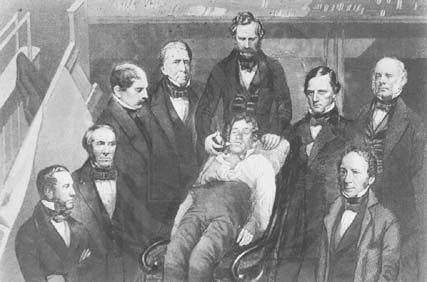 |
 |
Figure 1-6
Drawing by H. H. Hall in Rice's Trials
of a Public Benefactor illustrates the first public demonstration of ether
anesthesia at Massachusetts General Hospital on October 16, 1846.[482]
From left: Henry J. Bigelow
(1818–1890), the earliest advocate and sponsor for William T. G. Morton at
the hospital, who also wrote the classic article describing the first experiences
with ether anesthesia in the Boston Medical and Surgical Journal. Augustus
A. Gould, with whom Morton and his wife were boarding and who suggested
the design of the first inhaler. Gould also suggested the name Letheon. Jonathan
Mason Warren (1811–1867), son of John Collins Warren, who later
devised new surgical procedures for nasal deformity and cleft lip. Hall erroneously
places him at this event. Others (not shown) who were present are George Heywood,
house officer, and Eben Frost, who had a tooth pulled by Morton after ether administration
on September 30, 1846. John Collins Warren (1778–1856),
68-year-old Chief of Surgery at Massachusetts General Hospital who performed the
operation that day; William T. G. Morton, to whom
credit is given for introducing ether anesthesia to the world; Gilbert
Abbott, 28-year-old house painter and printer with a congenital vascular
tumor, visible in the drawing as a tumor below the left mandible; Samuel
Parkman, Morton's anatomy instructor at Harvard Medical School; and George
Hayward (1791–1863), 53-year-old senior surgeon at Massachusetts
General Hospital, who performed an excision of an arm mass with ether anesthesia
the following day, October 17, 1846. His operation for vesicovaginal fistula is
considered to be an original procedure. Also present was Solomon
D. Townsend, one of the prominent surgeons at Harvard Medical School.
(Courtesy of the Wood Library-Museum of Anesthesiology, Park Ridge, IL.)

 |
